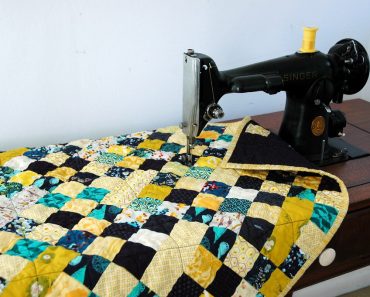Machine quilting is becoming increasingly popular among quilters. Quilters may use a variety of designs and straight machine quilting stitches, among other things. The good news is that you do not need a different sewing machine.
Straight line and free motion machine quilting are the two most common types of machine quilting. Straight line quilting is simpler, but both require some practice.

Straight Line Machine Quilting
A walking foot, often known as an even-feed foot, is a tool that allows you to machine quilt straight lines. A walking foot is a specialized pressure foot that grasps the top of the quilting cloth and advances it at the same speed as the quilt’s back, which is dragged by the sewing machine’s feed dogs.
To minimize distortion and pleats, move the quilt slowly through the machine. If one layer of a quilt sandwich is out of alignment with the other layers, it can cause distortion and pleats.
A walking foot is capable of producing gentle curves, but complex designs necessitate free-motion machine quilting methods.
Free Motion Machine Quilting
Although the techniques used in making fabric quilt designs are similar to those employed when hand quilting, there is still a learning curve. Even if you use a sewing machine with specialised machine quilting technology, it will take some practice to make the stitches. These are the foundations:
- Because free-motion machine quilting techniques utilize lowered feed dogs, there’s nothing to keep the quilt sandwich in check. The quilter has complete control over the movement.
- The speed of your movements and the speed at which you operate the sewing machine both contribute to stitch length.
- You may accomplish the same task on a darning foot or a quilting machine foot. A different sort of foot has larger openings and is comparable to a darning foot.

Watch for New Machine Quilting Options
The demand for sewing machines with features to make it simpler to machine quilt has risen in recent years, so manufacturers have introduced new models to meet sewing demands and requirements. The Bernina Stitch Regulator is one of the newest additions to the Bernina line that helps beginning machine quilters sew evenly spaced free-motion stitches. Other sewing machine makers have also created special presser feet to make using your equipment easier for quilters.
While high-end machines are wonderful, you can machine quilt with virtually any sewing machine. Most sewing machines include standard walking feet and free-motion equivalent feet.
Today’s quilters have access to more tools than those from the past. Rotary cutting techniques, an endless variety of fabrics produced with dyes that don’t bleed or change colour, threads for every purpose, and sewing machines loaded with time-saving and creativity-enhancing features are just a few of today’s advantages.
Stencils and other kinds of guides are available to assist you in machine quilting projects—even free-motion quilting stitches don’t need to be haphazard.
Getting Started with Machine Quilting
To get a feel for the art, begin by machine quilting a tiny project such as a table runner, mug rug, or baby quilt. If machine quilting proves to be one of your favourites, search for different types of machines to see which one would be best for you.


